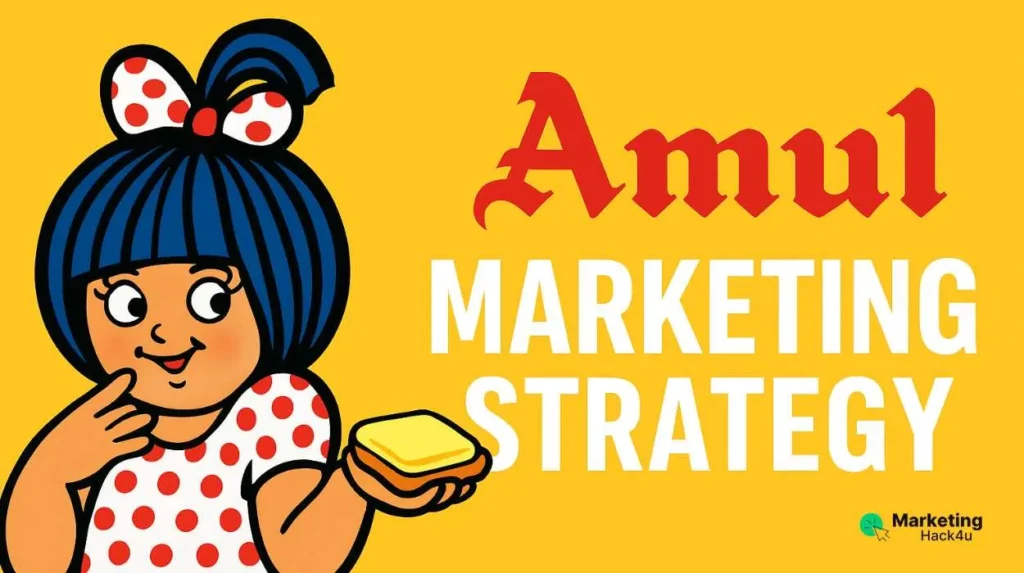Take the butter slab in your refrigerator. The one having the rosy little girl in the red polka-dotted dress on its wrapper. Or consider the glass of milk you take in the morning. These images immediately evoke a single name of Amul among millions of Indians. Amul is not only a brand, it is a piece of our everyday life, it is something that is in our kitchens and it is a tale of unbelievable success.
What made a tiny collectivity that began with farmers in Gujarat into one of the most popular and reputable brands in India? The solution is in an ingenious and emotional Amul Marketing Strategy in India. This plan does not concern the glitter and the formulas. It is about knowing how to relate with people, creating trust, and providing quality, day in day out. The total business division of the Amul brand exceeded a turnover of an enormous 80,000 crore (approximately 10 billion dollars) in the financial year 2023-24. We shall go into the details and know the basic but effective marketing strategy of Amul.
The brand in itself is so deep that it is net worth 4.1 billion dollars, and it is the top food brand in India. Amul gathers astonishing 32 million liters of milk each and every day through over 3.6 million farmer partners. These tremendous figures are the narrative of a marketing giant who captured the heart of a nation.
Summary of Amul: A Billion Drops.
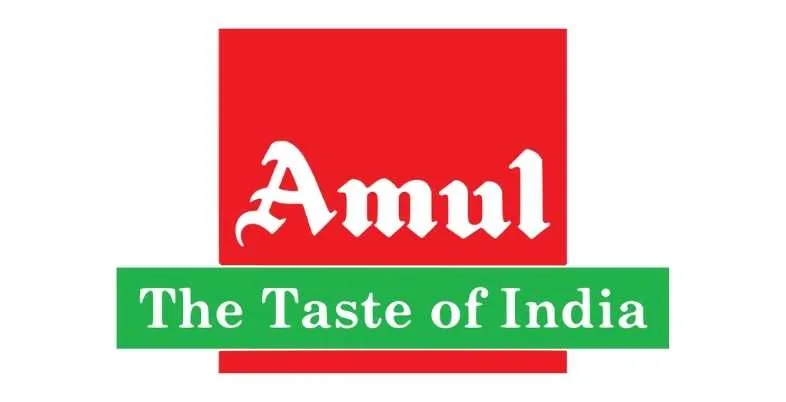
To explain the marketing strategy of Amul, we must first know about Amul. The history of the company, its spread, and its unusual design are the pillars, on which its prosperity is based.
A Short History: A White Revolution out of a Small Protest.
Amul had a history that dates back to as early as 1946, prior to the independence of India. The dairy farmers of the Kheda region in Gujarat were in a bad situation at the time. Polson dairy was the only single private dairy that dominated the entire market. This firm and its representatives would purchase milk of the poor farmers at a very low price and sell it at the city of Bombay (presently Mumbai) at an enormous profit. The farmers were victimized and disempowered.
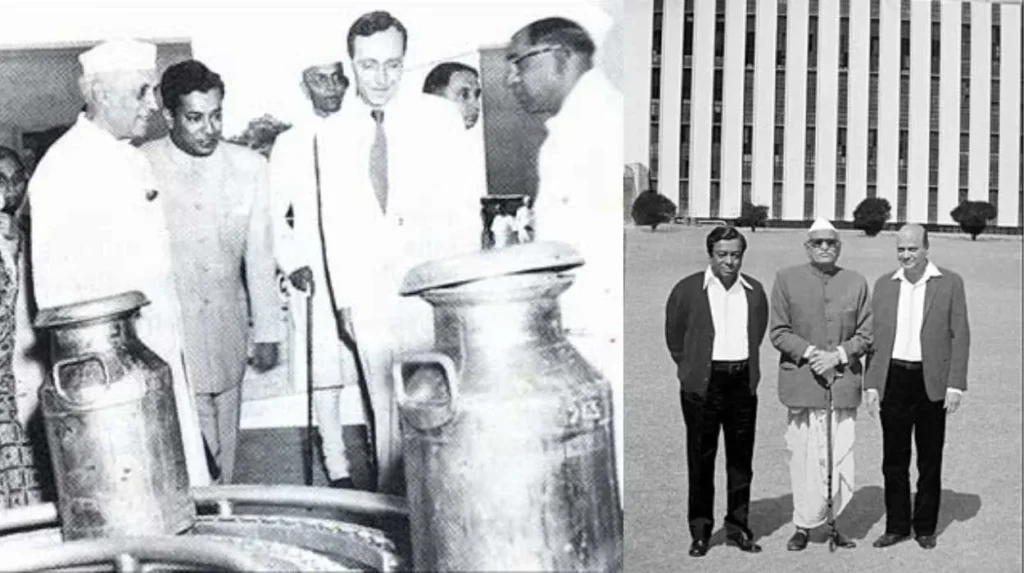
The farmers were fed up with this unjust system, so they approached a very wise and revered leader, Sardar Vallabhbhai Patel. He recommended that they cease selling milk to the middlemen. Rather, he replied, why not open your own dairy? Establish a cooperative, in which you, the farmers, are the owners. You milk your own, and sell it off yourself. This was a strong concept and the Kaira District Co-operative Milk Producers’ Union Ltd was formed. It began with only two villages and a few farmers.
On December 14, 1946, this small cooperative was registered. Verghese Kurien was an excellent manager and he joined them several years later. In India, he is referred to as the Father of the White Revolution. The cooperative under his leadership expanded at a phenomenal rate. In 1955, they had to have a brand name that was easy to recall.
They decided to name it Amul, which is the Sanskrit word Amulya, meaning priceless. This was an ideal name to describe the worth of the hard labor of the farmers and the quality of their commodity. The success of the brand was further fueled by the ingenious Amul Marketing Strategy in India, which was so effective that it spread throughout the country and helped India become the largest milk producer in the world, a nation that was once milk deficient.
Market Presence: In Every Home, In Every Heart.
| Category | Details (Sept 2025) | Source / Notes |
| Brand Valuation | $4.1 billion | Brand Finance India 100 – 2025 |
| Amul Brand Revenue | ₹90,000 crore (~$10.8B USD) | 12% YoY growth |
| GCMMF Turnover | ₹65,911 crore | 11% YoY growth |
| Revenue Projection (FY26) | ₹1 lakh crore (~$12B USD) | Driven by milk and related products |
| Expansion Plans | ₹10,000 crore investment over 2–3 years; 10–12 new plants | Infrastructure for dairy, ice cream, other products |
| Product Portfolio | Milk, butter, ghee, paneer, curd, cheese, chocolates, lactose-free products | Strengthening existing categories |
| Sustainability Initiatives | Large-scale bioethanol production from whey | Aligns with India’s Ethanol Blended Petrol (EBP) program |
| Market Position | India’s leading dairy brand | #1 in food brand ranking in India |
| Growth Drivers | Strong brand recognition, strategic expansion, sustainability focus | Ensures long-term market dominance |
Nowadays, Amul products are available nearly all over India. Go to a big supermarket in Delhi or a small local store in a remote village in Kerala and you will find the well-known Amul logo. This is what we refer to as a huge market presence.
The products of Amul are not only in India. Its dairy products are also exported to more than 50 countries such as the USA, Gulf region countries, Singapore, and Australia. This indicates that the people in the entire world are now enjoying the taste of India. Amul has established an amazing network to ensure that its products and particularly the fresh products such as milk and curd are delivered to all parts of the country as fresh and safe to drink.
Also Read: Amul Franchise Cost and Profits in India
Market Structure: Farmers owned Company.
This is the most exclusive thing about Amul. Amul is not a normal company under the ownership of one businessman or a collective of investors. It is a cooperative.
What does that mean? Suppose you and all your classmates are going to open a juice booth. Each one carries fruits at home. There are those who squeeze the juice, there are those who handle the money and there are those who sell it. The profits are divided equally at the end of the day. This is a cooperative.
The Amul model works in a similar three-tiered way:
- Village Level: There are small cooperatives at the village level. The farmers within the same village come together and sell their milk and they are paid instantly.
- District Level: In the district level, milk of a large number of village groups is gathered. The milk is processed by a District Milk Union which produces products such as butter, cheese and ice cream.
- State Level: On the state level, district unions merge into a State Marketing Federation (e.g. Gujarat Co-operative Milk Marketing Federation). This group is the seller and marketer of the products under the brand name Amul.
The most interesting fact is that the actual owners are the numerous farmers. These farmers get the profit that Amul makes and this enhances their lives. This gives the farmers the sense of ownership and pride and ensures quality milk.
Amul Marketing Strategy in India: The Four Pillar Formula.
The marketing strategy of Amul is commended as being a straight forward one. It does not use a jumbled language and it is also centered on four pillars which have made the brand remain strong over many years.
1. Pillar: Product Differentiation & Quality Focus (The What Pillar):
The first promise of Amul is regarding the products. The brand does not only have milk and butter but a massive list of items such as fresh milk, long-life milk, flavoured milk, curd, buttermilk, ghee, paneer, a wide range of cheeses, variety of ice-cream flavours, chocolates, condensed milk, and health drinks.
The presence of such a multitude is termed product diversification. That is to say that Amul offers something to each and every family, on any occasion.
2. Regular Branding & Advertising (The “How You Tell” Pillar):
Amul Girl is what comes to mind when individuals consider Amul ads. This pillar relates to the way Amul speaks to the customers. Amul created its own icon as opposed to paying a fortune to star endorsers.
The Utterly Butterly Delicious campaign with the catchy Amul Girl has been operating more than 50 years, which is why it is one of the longest ad campaigns in the world. This uniformity renders the brand a part of Indian culture. This branding strategy will be discussed further.
3. Pillar: Distribution & Supply Chain Efficiency (The “How You Reach” Pillar):
It is no good to have a great product and people cannot purchase it. The distribution network of Amul is the secret weapon. It is a complicated network connecting millions of farmers and millions of buyers on a daily basis. The three-level system discussed above is the beginning point.
The products come out of the state federation, to distributors, then to wholesalers, then to retailers (your local shop), and then to you.
4. Customer Engagement using Campaigns and Social Media (The “How You Connect” Pillar):
Amul does not merely retail products; it develops relationships. It has been running its topical advertisements over the years that discuss daily news and people feel that Amul knows their world. Amul has shifted this engagement to the internet in the recent years.
It reaches out to younger people through active and entertaining social media pages, posts recipes, organizes contests, and maintains the tradition of humorous commentary on the latest events. This makes the brand current and in the discussion.
Branding Strategy of Amul: The Girl in the Polka-Dotted Frock.
Amul has an ideal way of branding that is an example of how to establish a brand that is here to stay. It is easy to remember, emotional and catchy.
Iconic Amul Girl and Unchanging Message.

Amul Girl is, by all means, the core of the branding of Amul. In 1966, Sylvester daCunha, an advertising agency ASP, created her. This was to make a fun, playful mascot that will be enjoyed by all, especially by mothers and children. She is just like she was more than fifty years ago, with the same blue hair, the same polka-dotted frock.
The topical ads are magic. They are small, hand painted posters and newspaper advertisements that comment on the recent news, be it a major cricketing match, a new film, a political occasion or a fashion. The advertisements always carry a witty pun.
Emotional Connect & Nostalgia Factor
Amul is not a product to many Indians but a part of their childhood. They recall the flavor of Amul butter on toast prepared by their mothers or the happiness of having Amul ice cream cone on a summer evening. The brand is closely related to family moments and happy memories. This is called nostalgia.
A key element of the Amul Marketing Strategy in India is leveraging this emotional connection. Amul has been using the same Amul Girl and the same plain style over decades to exploit this emotion. Whenever individuals view Amul advertisements, it reminds them of their past in a comforting manner. This emotional attachment is far more powerful than a discount or a special offer, making customers feel as if they belong to the Amul family.
Brand Positioning: The Taste of India.
Amul has also very smartly branded itself as not only a dairy brand, but as The Taste of India. This tagline is brilliant. It implies that Amul is the true pure and multifaceted flavor of the whole nation. It identifies the brand with the Indian culture, traditions, and values.
Amul can be found in every corner of the Indian life whether it is the ghee to prepare Diwali sweets or the dahi to prepare a traditional meal, the milk to make a morning chai or whatever. Such a positioning causes Amul to feel like an Indian heritage brand, a brand that is a part of all.
Influence on Consumer Loyalty and retention.
All these branding campaigns lead to the same thing, which is amazing consumer loyalty. People trust Amul blindly. They are aware that they are purchasing a quality product at a reasonable cost when they purchase an Amul product. This is a trust that has been developed in 75 years, which is extremely difficult to destroy by the competitors.
The customers are not simply purchasing a product, but a promise of purity, a fragment of their own culture. That is why despite the numerous new brands in the market, millions of people are loyal to Amul. They do not use Amul, they trust in it.
Amul Digital Marketing Strategy.
Even a traditional brand like Amul must be online in the world filled with the internet and smartphones. And Amul has done this very well. They have borrowed their traditional marketing model and transformed it into the online era.
Amul is quite active in such platforms as Facebook, Twitter (now X), Instagram, and YouTube. They do not plan to bomb their users with the buy now messages. They are more concerned with interaction and narrative.
The Topical Ads Go Viral:
The Amul girl topical ads are witty and good in social media. They are made in haste, are timely in relation to what is trending, and are very shareable. Whenever there is a significant event, individuals have taken an active part in visiting the social media pages of Amul to know how the Amul Girl has something to say about it.
Interactive Content:
Amul constantly shares recipes on its products, conducts contests and quizzes, and poses questions to its subscribers. This makes their social media feeds entertaining. They may, e.g., share a basic recipe on how to make a cheese sandwich, and invite people to send pictures of their own sandwiches.
Celebrating India:
They are packed with postings that celebrate the Indian festivals, culture, and achievements. This further makes their brand name, The Taste of India, and appeals to the patriotic sentiments of their customers.
Amul Target Audience: To Everyone in India.
Who are the people Amul is selling its products to? The obvious solution is: everybody. This is referred to as mass marketing or undifferentiated marketing approach. Amul is not oriented towards a small, narrow target group of people. Rather, it is targeted at being a brand to the whole Indian nation, irrespective of their age, income, and location.
But they are quite cunning about it. Although the total brand is aimed at all people, they have certain products that are aimed at this or that segment of the audience:
- Children: Children have Amul Kool flavored milk, cheese slices, and various types of chocolates.
- To the Youth: They have products such as Amul Kool Café, energy drinks and fashionable flavors of ice cream.
- Health-Foradults: They offer such products as Amul Calci + milk (with additional calcium), probiotic dahi, and ice cream without sugar.
- To Families and Households: It is their main market. Fresh milk, butter, ghee and paneer are some of the products that are common in virtually every Indian kitchen.
The Amul strategy is, therefore, to be a mass brand, and a product to every individual in the mass.
Case Study Insights: The Magic in Action.
We should see some of the examples of how the marketing campaigns of Amul can be applied in the real world.
Case Study 1: Topical Ads:
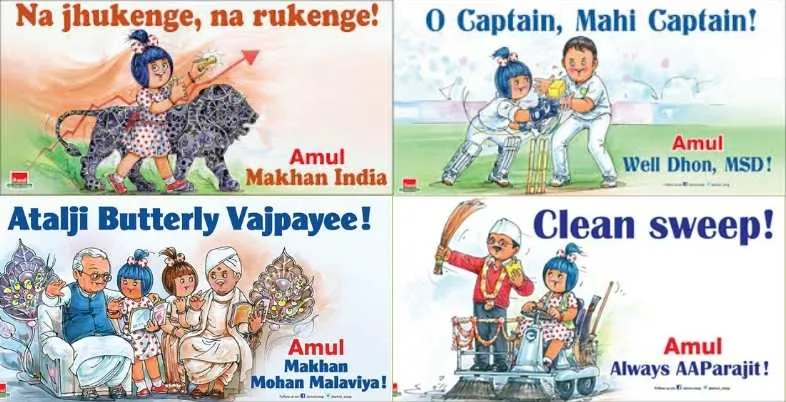
When India wins a big tournament in cricket, within hours, Amul will issue an advertisement where Amul Girl joins the team and there will be a clever pun such as We have Kohli-fied the finals or Just Rohit we have won! An advertisement may be done using the characters of the movie where the Amul Girl is dancing with them when they win the international award such as the popular Bollywood film, RRR, with the tagline such as RRReally tasty.
Results: These advertisements become viral on whatsapp and social media. They create millions of views and shares. The outcome is huge brand recall (people will remember the name Amul) at a very minimal expense. It causes the brand to appear quite amiable, witty and never out of fashion.
Case Study 2: Festive Campaigns:
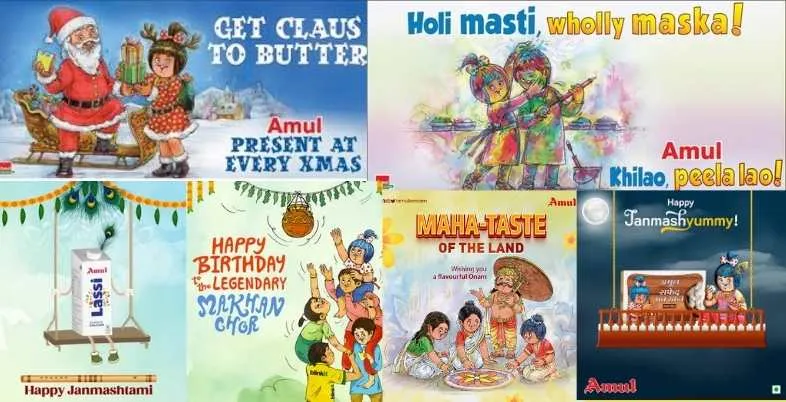
Amul does campaigns during festivals such as Diwali whereby people are encouraged to prepare sweets at home using Amul Ghee and Amul Mithai Mate (condensed milk). Their adverts depict joyful families that are partying.
Results: This links the brand to joyful and emotional occasions in the life of a consumer. It stimulates the sales of certain goods in the period of the festival and supports the image of the brand as the inseparable part of the Indian tradition. The payback period is not immediate sales, but the establishment of an emotional relationship in the long term.
Pricing Strategy of Amul: Quality for the Masses
The pricing and marketing strategy of Amul is one of the largest factors that made Amul successful. Amul has been a low-cost airline company. The idea is to ensure as many Indians as possible can afford high-quality nutrition.
| Aspect | Details |
| Strategy Name | Quality for the Masses |
| Objective | Affordable pricing to reach a wide consumer base while maintaining high quality |
| Product Range & Approx. Prices | Milk – ₹55/litre, Butter – ₹250/200g, Ghee – ₹550/1kg, Paneer – ₹280/200g, Ice Cream – ₹60/100ml, Chocolates – ₹10–₹50/piece, Cheese – ₹350/200g |
| Price Positioning | Competitive pricing compared to local and private dairy brands |
| Target Audience | Middle-class and mass-market consumers across India |
| Value Proposition | High-quality dairy products at reasonable prices, creating trust and brand loyalty |
| Promotional Angle | Emphasizes reliability, nostalgia, and everyday usage rather than discounts |
| Impact | Strong market penetration and brand recall across urban and rural India |
Low-Cost Pricing Strategy of Amul.
What is the way Amul can offer its products at a cheaper rate compared to most of its competitors? Its solution is in its collaborative form.
- No Intermediaries: Amul receives the milk of farmers. This cuts out the middle men who would otherwise make a cut adding to the overall price.
- Efficiency: Their supply chain is highly efficient and this helps to make costs low.
- Focus on Volume: Amul is committed to selling a large number of products at a low profit margin as opposed to selling a few products at a high profit margin.
Competitive Pricing vs. Value Perception.
The pricing of Amul is highly competitive. However, one is to realize that to be of low price does not imply to be of low quality to the consumer. Amul has been able to build the image of high value. This implies that customers have a feeling that they are receiving a good product at the current price they are paying. Such an affordable price and the quality that is trusted is a winning formula.
Pricing Across Categories
Amul employs various pricing strategies of its various products:
- Milk: Milk is liquid milk, which is a primary necessity. To ensure that it is affordable to all, Amul charges it at very competitive prices and at times with minimal profit.
- Butter, Ghee, and Cheese: They are referred to as value added products. Their profit margin is slightly higher than that of milk.
- Ice Cream and Chocolates: These are life time products. They are still affordable but priced to compete with other such snack and dessert brands in the market.
The intelligent pricing approach enables marketing strategy of Amul to achieve its social cause of offering affordable nutrition in addition to operating a profitable and sustainable business.
Market Structure / Competitive Advantage of Amul.
What is the competitive advantage that the marketing strategy of Amul has that other companies struggle to counter with? It is a blend of three strong strengths.
1. Cooperative Model vs. Private Dairy Companies:
The greatest strength of the marketing strategy of Amul is its cooperative structure owned by farmers. This provides it with a loyal and dedicated milk supply of high quality. In the case of a private company obtaining milk can be a massive burden. They must struggle to be supplied and prices are subject to change. In the case of Amul, the owners are the suppliers and this establishes a stable and committed relationship.
2. Distribution Network as a Moat:
Suppose that there is a castle with a deep, broad ditch of water round it, called a moat. The moat keeps the enemies off the castle. Amul has moat in its distribution network. It is so immense, profound, and effective, that it spans all parts of India, and it is nearly impossible that a new entrant will be able to construct the same. This network gives Amul a colossal advantage over other companies since they cannot reach customers in the same way as Amul, particularly in the small towns and rural regions.
3. Diversification and Innovation of the Product:
Amul never stops innovating. It is continually introducing new products and venturing into new areas. In the recent past, it has introduced products such as camel milk, lactose free milk and even frozen foods such as potato wedges. This innovative continuality keeps the brand interesting, fulfills the evolving demands of consumers and creates new growth possibilities.
Conclusion: The Perennial Taste of Trust.
The Amul Marketing Strategy is a strong teaching on simplicity, consistency and connection. It is a plan that is not based on massive budgets but rather on extensive knowledge of the Indian consumer. Amul has not only established an effective business through concentrating on the basics: a superior product, reasonable prices, unbeatable coverage and sincere communication. It has created a national institution.
The brand has impacted many people, starting with the farmer who receives a good price on his milk, to the child who has a scoop of Amul ice cream. The case of Amul shows that a brand can be as commercial as it is good and vice versa. As it moves on to innovate and expand, Amul still is, and probably will always be, the real Taste of India, a taste of innocence, confidence, and the group soul of millions.
Also Read: Mother Dairy Safal Franchise
FAQs
1. What is the full form of Amul?
Amul is an abbreviation of Anand Milk Union Limited, which was named after the town of Anand in Gujarat where it originates.
2. Who is the famous Amul Girl?
The mascot of the brand is the Amul Girl, a small girl in a polka-dotted dress that has been used in their topical advertisements since 1966.
3. What is unique to the business model of Amul?
Amul is a cooperative business model and this implies that it belongs to the 3.6 million dairy farmers who sell milk to Amul and the profits are returned to them.
4. Why are Amul products appoint inexpensive?
Amul has a low-cost pricing strategy. The fact that it is a cooperative that receives the milk directly at the farm allows it to avoid middlemen; this contributes to its operations being low, and this is why its products are affordable to all.
